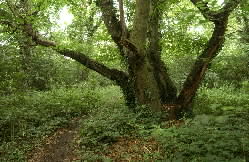 Whilst much of Britain was cleared of native woodland during prehistory, many remnants have subsequently been maintained as a valuable resource for hundreds of years. Some formed parts of the medieval royal forests, whilst others have a long associated history with industries such as iron and pottery production. Some provided timbers (and still do) for ships of war such as the flagship HMS Victory and most woods contain local myths, legend and folklore. Many woodlands today are themselves, or contain part of an ancient wooded landscape. Ancient woodlands may also have a long associated biodiversity and this is often seen in the ground flora where certain species can be used to identify areas of long and continued woodland cover.
Whilst much of Britain was cleared of native woodland during prehistory, many remnants have subsequently been maintained as a valuable resource for hundreds of years. Some formed parts of the medieval royal forests, whilst others have a long associated history with industries such as iron and pottery production. Some provided timbers (and still do) for ships of war such as the flagship HMS Victory and most woods contain local myths, legend and folklore. Many woodlands today are themselves, or contain part of an ancient wooded landscape. Ancient woodlands may also have a long associated biodiversity and this is often seen in the ground flora where certain species can be used to identify areas of long and continued woodland cover.
Many woodlands in Britain are regarded as PAWS (Plantations on Ancient Woodland Sites). In recent years there has been considerable interest in identifying and prioritising these sites under coniferous plantation for converting back to native woodland species. Such restoration should increase the cultural value, heritage value and biodiversity of the site in question. Greater impetus has arisen from restoration targets within the native woodland Habitat Action Plans (HAPs) and the requirements of UK Woodland Assurance Standard (UKWAS).
One example of an ancient woodland project can be found in the Northants Forest District where the partly Forestry Commission funded project aims to:
- Collate and analyse the results of the Ancient Woodland Project, and to assess their importance in the light of local and regional research priorities.
- Summarise the present state of knowledge concerning the history of ancient woodlands and their management in the Northants Forest District, in order to inform future research and management strategy.
- Make recommendations concerning the management of historic features within Forest Enterprise woodlands and other woodland of similar character and history.
Restoration guide
Restoration of native woodland on ancient woodland sites(PDF)
This publication is a valuable tool in the restoration of native ancient woodland sites. The practice guide outlines what restoration is and why it should be considered. It provides methods of site assessment for restoration and practical advice on how it may be achieved.
Forestry Commission Practice Note 14.
Also available in hard-copy.
